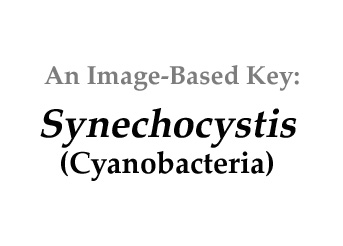|
|
|
|
||
|
|
|
|||
|
Click on images for larger format |
||||
Name derivation: |
||||
|
From the Greek synecho, to hold together, and cystis , a cell. |
||||
Classification: |
||||
|
Synechocystis Sauvageau 1892; 29 of 34 species descriptions are currently accepted taxonomically (Guiry and Guiry 2013). Order Chroococcales; Family Chroococcaceae or Merismopediaceae. |
||||
Morphology: |
||||
|
Small (2µm diameter) spherical photosynthetic unicells without mucilaginous sheath, cell longer than wide. Can form small colonies. Capable of switching between anoxigenic and oxygenic photosynthesis gaining electrons from H2S (anoxic) or H2O (oxygenic). |
||||
Nitrogen storage: |
||||
Synechocystis produces cyanophycin with cyanophycin synthetase, a polypeptide with many arginine and aspartate residues that forms intracellular granules capable of degradation by cyanophycinase when the cell is nitrogen starved (Hai et al. 1999, Aboulmagd et al. 2000). Other chemotrophibacteria such as Acinetobacter calcoaceticus have a similar mechanism (Krehenbrink and Steinbűchel 2004). |
||||
Movement: |
||||
|
Capable of positive phototaxis (orientated movement toward a light source) and photokinesis (movement proportional to light intensity). ‘Gliding’ movement involves pili (Chung et al. 2004). |
||||
Similar genera: |
||||
|
There appears to be an overlap between Synechococcus Nageli 1849 and Synechocystis Sauvageau 1892, the former described in more detail (Geitler 1932). It is likely the two genera are each polyphyletic given the number of lumping and splitting by a variety of systematists (Whitton 2011). |
||||
Habitat: |
||||
|
Freshwater plankton, both photosynthetic and heterotrophic in the dark, with transitions mediated by a circadian clock. Dark heterotrophy requires 5 – 15 minutes of pulsed blue light per day at 40 – 75 quanta (mechanism not known), and a suitable organic carbon source, e.g. glucose (Anderson and McIntosh 1991). |
||||
Use: |
||||
|
Synechocystis sp. PCC 6803 is a model cyanobacterium – the first photosynthetic organism to have its entire genome determined, and able to acquire genes by horizontal transfer. Isolated from a freshwater lake, several studies of its genotype reveal its ability to transform readily, therefore can be manipulated with 'targeted' gene replacement. Currently it is considered to be a phototrophic cell factory that can be modified genetically to study gene-protein relationships, generation of renewable biofuels and produce diverse chemicals (reviewed by Yu et al. 2013). More description can be found online. |
||||
References: |
||||
|
Aboulmagd, E., F.B. Oppermann-Sanio and A. Steinbűchel 2000. Molecular characterization of the cyanophycin synthetase of Synechocystis sp. PCC6308. Archiv fur Microbiology 174:297-306. Anderson, S.L. and L. McIntosh 1991. Light-activated heterotrophic growth of the cyanobacterium Synechocystis sp. strain PCC 6803: as blue-light-requiring processs. Journal of Bacteriology 173(9):2761-2767. Chung, Y-Y, J.P. Young, Y-J Moon, E-M Lee, and J-S Choi 2004. Photokinesis of Cyanobacterium Synechocystis sp. PCC 6803. J. Photoscience 11(3):89-94. Guiry, M.D. and G.M. Guiry 2013. AlgaeBase. World-wide electronic publication, National University of Ireland, Galway. http://www.algaebase.org; searched on 04 September 2013. Hai, T., F.B. Oppermann-Sanio and A. Steinbűchel 1999. Ppurification and characterization of cyanophycin and cyanophycin synthetase from the thermophilic Synechococcus sp. MA19. FEMS Microbiology Letters 181:229-236. Knoop, H., Y. Zilliges, W. Lockau, and R. Steuer 2010. The Metabolic Network of Synechocystis sp. PCC 6803: Systemic Properties of Autotrophic Growth. Plant Physiology 154:410-422. Krehenbrink, M. and A. Steinbűchel 2004. Partial purification and characterization of a non-cyanobacterial cyanophycin synthetase from Acinetobacter calcoaceticus strain ADP1 with regard to subastrate specificity, substrate affinity and binding to cyanophycin. Microbiology 150(8):2599-2608. Yu, Y., L. You, D. Liu, W. Hollinshead, Y.J. Tang and F. Zhang 2013. Development of Synechocystis sp. PCC 6803 as a phototrophic cell factory. Marine Drugs 2013(11):2894-2916. |
||||
|
Home / Cyanobacteria / Unicells / Synechocystis |
||||





